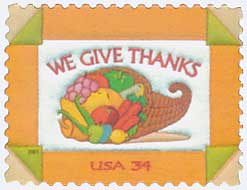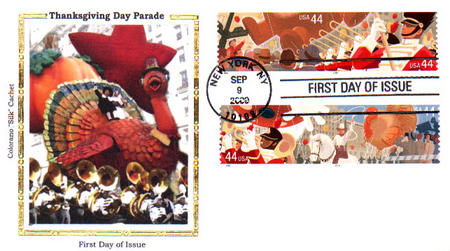
# 4420 - 2009 44c Thanksgiving Day Parade: Turkey Balloon
Thanksgiving Day Parade
Turkey Balloon
Issue Date: September 9, 2009
City: New York, NY
In 1927, promoters promised that the Thanksgiving Day Parade would be “bigger and better than ever,” and it was. For the first time, giant balloons traveled along the streets of New York City.
Balloons were introduced to replace the live zoo animals that frightened some of the children. The crowds of that era had never seen anything like the new balloons. New Yorkers were awed as giant dinosaurs, elephants, and tigers “peered” through fifth-story apartment windows.
In 1929, the balloons were released with the promise of a $50 reward for anyone who found them. The release program ended three years later when a man attempted to use a plane to retrieve a giant cat balloon. The balloon tangled around the wing and the plane almost crashed into Broadway.
The parades were canceled during World War II, and the balloons were donated to the war effort. More than 650 pounds of scrap balloon rubber went towards making vital tires and life rafts.
Today, the balloons are fashioned after characters from famous cartoons, video games, and Internet websites. Although the characters have changed, the sight of these huge bobbing figures never fails to enchant spectators. They have become a signature of New York City’s Thanksgiving Day Parade.
Washington & Lincoln’s Thanksgiving Celebrations

On November 26, 1789, the nation celebrated Thanksgiving for the first time under a presidential proclamation. Decades later, President Lincoln issued a similar proclamation that made the holiday permanent.
Though colonists had held harvest celebrations of thanks since the 1600s, it wasn’t an official holiday celebrated everywhere at the same time. Rather, it was celebrated in different places, at different times, and for different reasons.

That changed in 1789. On September 25, Elias Boudinot presented a resolution to the House of Representatives asking that President Washington “recommend to the people of the United States a day of public thanksgiving and prayer… [for] the many signal favors of Almighty God.”

Congress approved the resolution and appointed a committee to approach Washington. Washington agreed and issued his proclamation on October 3. In it, he asked all Americans to observe November 26 as a day to give thanks to God for their victory in the Revolution as well as their establishment of a Constitution and government. He then gave it to the governors of each state and asked them to publish it for all to see. (You can read Washington’s proclamation here.)

Washington’s proclamation was then printed in newspapers around the country, leading to public celebrations of Thanksgiving on November 26. For his part, President Washington attended services at St. Paul’s Chapel in New York City and donated beer and food to those in debtors’ prisons.
In the years that followed, Presidents John Adams and James Madison issued similar proclamations, but none were permanent. In 1817, New York officially established an annual Thanksgiving holiday. Other northern states followed suit, though they weren’t all on the same day. Some presidents, such as Thomas Jefferson, opposed the proclamations. He believed it was contradictory to the nation’s beliefs in the separation of church and state.

Sarah Josepha Hale (famous for the nursery rhyme “Mary Had a Little Lamb”) began a rigorous campaign in 1827 to make Thanksgiving a national holiday. She published articles and wrote letters to countless politicians, to no avail. Finally, in 1863, at the height of the Civil War, President Lincoln received one of her letters and was inspired.
On October 3, Lincoln issued his own proclamation, establishing the last Thursday of November as a day of Thanksgiving. In particular, to pray for those who lost loved ones in the war and to “heal the wounds of the nation.” (You can read Lincoln’s proclamation here.) The first Thanksgiving celebrated under Lincoln’s proclamation was that year on November 26.

Thanksgiving continued to be celebrated on the last Thursday of November until 1939, when President Franklin Roosevelt moved it up a week to increase retail sales during the Great Depression. Americans were outraged and dubbed it “Franksgiving.” Two years later, he reversed his policy and signed a bill making Thanksgiving the fourth Thursday of November, as it has remained ever since.
Thanksgiving Day Parade
Turkey Balloon
Issue Date: September 9, 2009
City: New York, NY
In 1927, promoters promised that the Thanksgiving Day Parade would be “bigger and better than ever,” and it was. For the first time, giant balloons traveled along the streets of New York City.
Balloons were introduced to replace the live zoo animals that frightened some of the children. The crowds of that era had never seen anything like the new balloons. New Yorkers were awed as giant dinosaurs, elephants, and tigers “peered” through fifth-story apartment windows.
In 1929, the balloons were released with the promise of a $50 reward for anyone who found them. The release program ended three years later when a man attempted to use a plane to retrieve a giant cat balloon. The balloon tangled around the wing and the plane almost crashed into Broadway.
The parades were canceled during World War II, and the balloons were donated to the war effort. More than 650 pounds of scrap balloon rubber went towards making vital tires and life rafts.
Today, the balloons are fashioned after characters from famous cartoons, video games, and Internet websites. Although the characters have changed, the sight of these huge bobbing figures never fails to enchant spectators. They have become a signature of New York City’s Thanksgiving Day Parade.
Washington & Lincoln’s Thanksgiving Celebrations

On November 26, 1789, the nation celebrated Thanksgiving for the first time under a presidential proclamation. Decades later, President Lincoln issued a similar proclamation that made the holiday permanent.
Though colonists had held harvest celebrations of thanks since the 1600s, it wasn’t an official holiday celebrated everywhere at the same time. Rather, it was celebrated in different places, at different times, and for different reasons.

That changed in 1789. On September 25, Elias Boudinot presented a resolution to the House of Representatives asking that President Washington “recommend to the people of the United States a day of public thanksgiving and prayer… [for] the many signal favors of Almighty God.”

Congress approved the resolution and appointed a committee to approach Washington. Washington agreed and issued his proclamation on October 3. In it, he asked all Americans to observe November 26 as a day to give thanks to God for their victory in the Revolution as well as their establishment of a Constitution and government. He then gave it to the governors of each state and asked them to publish it for all to see. (You can read Washington’s proclamation here.)

Washington’s proclamation was then printed in newspapers around the country, leading to public celebrations of Thanksgiving on November 26. For his part, President Washington attended services at St. Paul’s Chapel in New York City and donated beer and food to those in debtors’ prisons.
In the years that followed, Presidents John Adams and James Madison issued similar proclamations, but none were permanent. In 1817, New York officially established an annual Thanksgiving holiday. Other northern states followed suit, though they weren’t all on the same day. Some presidents, such as Thomas Jefferson, opposed the proclamations. He believed it was contradictory to the nation’s beliefs in the separation of church and state.

Sarah Josepha Hale (famous for the nursery rhyme “Mary Had a Little Lamb”) began a rigorous campaign in 1827 to make Thanksgiving a national holiday. She published articles and wrote letters to countless politicians, to no avail. Finally, in 1863, at the height of the Civil War, President Lincoln received one of her letters and was inspired.
On October 3, Lincoln issued his own proclamation, establishing the last Thursday of November as a day of Thanksgiving. In particular, to pray for those who lost loved ones in the war and to “heal the wounds of the nation.” (You can read Lincoln’s proclamation here.) The first Thanksgiving celebrated under Lincoln’s proclamation was that year on November 26.

Thanksgiving continued to be celebrated on the last Thursday of November until 1939, when President Franklin Roosevelt moved it up a week to increase retail sales during the Great Depression. Americans were outraged and dubbed it “Franksgiving.” Two years later, he reversed his policy and signed a bill making Thanksgiving the fourth Thursday of November, as it has remained ever since.












